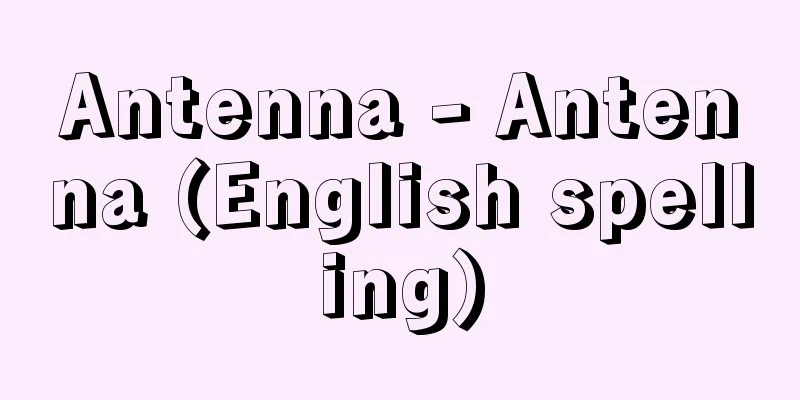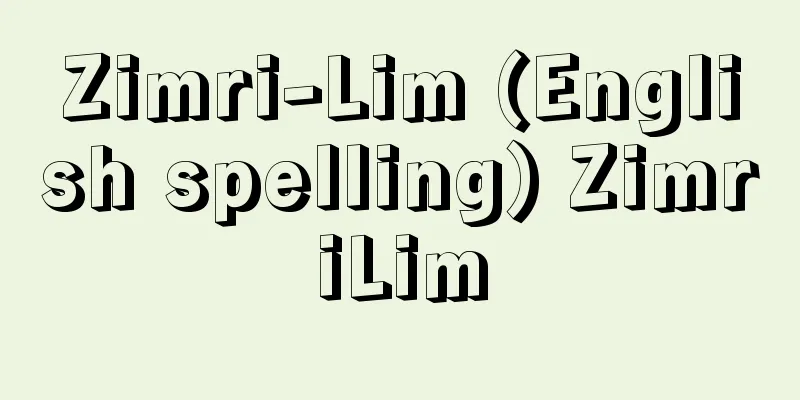Antenna - Antenna (English spelling)

|
A device for absorbing (receiving) or emitting (transmitting) radio waves. To send electrical energy or information through space without using a transmission line, the energy from the transmitter must be converted into radio waves and efficiently radiated into space, and the radio waves radiated into space must be efficiently received by the other party. A device that converts electrical energy into radio waves and receives radio waves in this way is called an antenna. Antennas are essential elements for transmitting radio signals or electrical energy between points separated by space, such as in broadcasting, communications, radar, and remote sensing. In the early days of wireless communications without wires, linear antennas were used, so they were called aerials, and the English word antenna also means an insect's antenna. One of the functions of an antenna is to be an efficient converter of electrical energy between electrical circuits and space, but another important function is that it can emit strong radio waves in a specific direction and not in other directions, depending on its shape and dimensions (especially the dimensions relative to the wavelength of the radio waves). This is called directionality. A receiving antenna is highly sensitive to receiving radio waves from a specific direction in space and does not receive radio waves from other directions. Antennas are very useful in allowing multiple wireless systems to coexist in the same space without interference. The simplest and most typical antenna is a parallel twin line (called a Lecher line) bent at a right angle at a quarter of the wavelength from the end, and is called a half-wave antenna (half-wave antenna) or dipole antenna. The radio waves emitted from this half-wave antenna are axially symmetrical around the antenna, and are strongly radiated at right angles in the plane that includes the antenna, with a figure-of-eight directivity. When used for reception, a voltage is generated at the connection point between the transmission line and the antenna, i.e., the antenna terminal, and the magnitude of this voltage varies depending on the direction from which the radio waves arrive, with the radio waves from the front direction being the strongest, resulting in the same figure-of-eight output voltage as when radiating. In this way, the directivity of an antenna is the same whether it is used for transmission or reception. Another basic linear antenna is one in which the ends of two parallel wires are shorted, half the wavelength from the ends is fixed, and the center is stretched to form a circle, called a one-wavelength loop antenna, which radiates strong radio waves perpendicular to the surface of the loop. Antennas in practical use are various combinations of half-wavelength antennas and one-wavelength loop antennas made slightly longer or shorter. In what is called a T-shaped antenna for radio broadcasting, the conductor of the vertical part becomes the main body of the antenna. Its length is about a quarter wavelength, and the earth becomes the conductor, forming a mirror image and functioning equivalent to a half-wave antenna. The antenna attached to the roof of a taxi radio has the same principle of operation. It is called a monopole antenna because it is a single rod. The retractable antenna of the police radio and commercial radio used in airport lobbies is called a whip antenna because it bends like a whip. This also works in the same way as a monopole antenna, but since the antenna mounting surface of the radio, which corresponds to the ground plate, is small, the entire radio acts as the lower conductor of a dipole antenna. Since the characteristics deteriorate when held by a person or close to the body, the length of the monopole antenna is about half the wavelength instead of a quarter wavelength, improving the characteristics during operation. Antennas that are familiar in our daily lives include those that receive distance measurement signals from GPS (Global Positioning System) satellites, which are necessary for car navigation systems. Microstrip antennas are usually used for these. Contactless IC cards such as JR's Suica and Edy use loop antennas wound multiple times along the four sides of the card. To broaden the frequency band, conductors of about half a wavelength are arranged in a military formation, and are called bat wing antennas because of their bat wing shape. If these are combined at right angles and the phase of each power supply current is shifted by 90 degrees, an almost uniform directivity can be obtained in the plane perpendicular to the vertical axis. This is called a turnstile antenna, and a superturnstile antenna that is stacked in several stages is widely used for television broadcasting. The television broadcasting antenna installed on the Tokyo Skytree, which was completed in 2012, uses a twin loop antenna, which is a vertically connected multiple one-wavelength loop antennas with parallel transmission lines. The most popular antenna for television reception is the Yagi-Uda antenna. In 1926 (Taisho 15), Yagi Hidetsugu and Uda Shintaro invented a five-element antenna, which is an example of a Yagi-Uda antenna. The conductors slightly longer than half the wavelength have the properties of a reflector, and the shorter ones have the properties of a waveguide, so these are placed in front of and behind the radiator to give it a sharp directivity in the direction of arrangement. Antennas that use one-wavelength loop antennas instead of the half-wavelength antennas that are components of the Yagi-Uda antenna are also used for television transmitting and receiving antennas. In addition, a corner reflector antenna is an antenna that is surrounded by a partition made of conductive plates that are combined at right angles, and is widely used as an antenna for the VHF band. A helical antenna is a type of antenna that is made by winding a conductor that is quite long compared to the wavelength (several to 10 wavelengths) into a spiral shape and connecting it to the inner conductor of a coaxial line. This is a so-called circularly polarized antenna in which the direction of the electric field rotates around the axis of the spiral, and it radiates a sharp beam-like radio wave in the axial direction and has a very wide frequency characteristic. The antennas used in mobile communication, i.e., base stations for mobile phone services, are array antennas with dipole antennas arranged vertically in front of a metal plate. The directivity of the antenna in the horizontal plane is a sector-shaped (60-180 degrees) beam, and can be set to 60 degrees, 120 degrees, etc. by devising the structure of the metal plate. In the vertical plane, the gain (an index showing the concentration of radio waves, i.e. the sharpness of the directivity) and interference with other cells are taken into consideration when designing, and the beam is usually tilted so that the peak of the beam is located inside the edge of the own cell. Metal rods were previously used as dipole elements, but printed dipoles using printed circuit boards are now used due to their light weight and ease of manufacture and assembly. In addition, in order to accommodate the rapid development and expansion of systems using multiple frequencies since 2000, frequency-sharing antennas that can use three frequencies simultaneously with one antenna have also been developed. On the other hand, PHS base station antennas appear to have two or four rods set up in parallel, but these are also array antennas consisting of several printed dipoles arranged vertically, housed in a resin pipe with a diameter of 10 to 20 mm. The reason for the existence of multiple rods is to provide diversity. For mobile phone antennas, the use of external whip antennas has shifted to built-in antennas since the early 2000s. Personal computers also have built-in flat antennas for wireless LAN. In order to achieve even smaller size and higher performance, development of antennas that use metamaterials (artificially created electromagnetic material properties that do not exist in nature) is also progressing. As frequencies increase and wavelengths become shorter, such as around centimeters, the reflection and refraction of radio waves become similar to the properties of light, and the principles of searchlights and telescopes for light are used as they are. Radio waves with wavelengths of 30 centimeters or less, up to about 1 centimeter, are called microwaves or ultra-high frequency waves, and paraboloidal reflector antennas are used in this range. If a half-wave antenna is placed at the focus, the reflected waves will be parallel due to the nature of the parabolic surface, and will be strongly radiated only in the forward direction. As excitation antennas, half-wave antennas with reflectors, electromagnetic trumpets with the tip of a waveguide broadened to a trumpet shape, and horn antennas are used. Horn antennas come in a variety of structures, from the usual cone or pyramid structure to corrugated horns and dual-mode horns that can improve antenna efficiency and cross-polarization discrimination. These parabolic antennas are used in various structures depending on the excitation method. A Cassegrain antenna is a type of antenna that was used in telescopes in the 17th century. A subreflector with a hyperboloid of revolution with the same focus is placed in front of a parabolic mirror, and is illuminated from behind by an electromagnetic trumpet. The Cassegrain antenna was used in telescopes in the 17th century. A Gregorian antenna is used when the subreflector is an ellipsoid of revolution. An offset Cassegrain antenna is used when the center is shifted to eliminate the shielding effect of the subreflector, and the upper half is used. An offset paraboloidal reflector antenna is used when the subreflector is directly excited by an electromagnetic trumpet instead of the subreflector. One type of antenna that is surrounded by a conductive plate is called a horn reflector antenna, and is used for broadband microwave communication lines that simultaneously transmit and receive frequencies such as 4000 MHz, 5000 MHz, and 6000 MHz. Offset parabolic antennas are widely used as antennas for receiving broadcasting satellites, with the high-frequency receiver built into the primary radiator. In addition, offset parabolic antennas are also widely used as satellite-mounted antennas, where they are combined with a primary radiator consisting of multiple horn rows to realize an elaborate "shaped beam" or are used as multi-beam antennas. On the other hand, large reflector antennas with subreflectors are used as earth station antennas for international satellite communications. For this antenna, a technology was devised to improve antenna efficiency by modifying the mirror surfaces of the main and subreflectors from rotating quadratic mirrors (paraboloids, hyperboloids, etc.), and this technology was applied to the design of earth station antennas around the world. Furthermore, with offset-type dual reflector antennas, there are no obstructions in the radio wave path, and mirror surface modification technology can be applied, so antenna characteristics close to ideal are realized. [Toshio Sekiguchi and Kenichi Kagoshima] "Antennas and Radio Wave Propagation" by Mushiaki Yasuto (1961, Corona Publishing) ▽ "Antenna Engineering" by Endo Keiji, Sato Motonari, and Nagai Jun (1969, Nikkan Kogyo Shimbun) ▽ "Antennas Illustrated" by Goto Naohisa (1995, Institute of Electronics, Information and Communication Engineers) ▽ "New Antenna Engineering - Antenna Technology in the Age of Mobile Communications" by Arai Hiroyuki (1996, Sogo Electronics Publishing) ▽ "Small, Planar Antennas" by Haneishi Misao, Hirasawa Kazuhiro, and Suzuki Yasuo (1996, Institute of Electronics, Information and Communication Engineers) ▽ "Illustrated Antenna Systems for Mobile Communications" by Fujimoto Kyohei, Yamada Yoshihide, and Tsunekawa Koichi (1996, Sogo Electronics Publishing) ▽ "Antennas and Radio Wave Propagation" by Miwa Susumu and Kaku Nobuyuki (1999, Tokyo Denki University Press) ▽ "Introduction to Antennas and Radio Wave Propagation," revised second edition (2001), edited and published by the Telecommunications Advancement Foundation" ▽ "Introduction to Radio Wave and Antenna Engineering," written by Tsukiji Takehiko (2002, Sogo Electronics Publishing)" ▽ "Adaptive Antenna Technology," written by Kikuma Nobuyoshi (2003, Ohmsha)" ▽ "Modern Antenna Engineering," written by Sato Gensada, Kawakami Haruo, and Taguchi Mitsuo (2004, Sogo Electronics Publishing)" ▽ "Antenna Design in the Ubiquitous Era: The Latest Technology for Broadband, Multiband, and Close-Range Communications," written by Nehiya Hideyuki and Ogawa Maki (2005, Tokyo Denki University Press)" ▽ "Antenna Engineering Handbook," second edition, edited by the Institute of Electronics and Communication Engineers (2008, Ohmsha)" [References] | | | | | | | | |©Shogakukan "> Antenna Basics Source: Shogakukan Encyclopedia Nipponica About Encyclopedia Nipponica Information | Legend |
|
電波を吸収(受信)または放射(送信)するための装置。電気的エネルギーや情報を伝送線路を用いず空間を通して送るには、送信機からのエネルギーを電波に変えて空間に効率よく放射させなければならないし、また相手側では、空間に放射された電波を効率よく受信しなければならない。このように電気的エネルギーを電波に変えたり、また、電波を受信する装置をアンテナという。アンテナは放送、通信、レーダー、リモート・センシングなど、空間を隔てた地点間の電波による信号、または電気エネルギーの授受に不可欠な素子である。線路を用いない無線通信の初期には、線状のアンテナが用いられたので空中線とよばれ、英語のantennaも昆虫の触角を意味している。 アンテナの機能の一つは、電気回路と空間との間の電気エネルギーの効率的な変換器であるが、もう一つの重要な働きとして、その形状、寸法(とくに電波の波長に対する相対寸法)により、特定の方向に強く電波を出し、その他の方向には出さないという機能を有している。これを指向性という。受信アンテナでは、空間の特定の方向からの電波を感度強く受信し、その他の方向からの電波は受けないようにする。同一空間で複数の無線システムが存在しても互いに混信することなく共存させるようにするために、アンテナの効用は大きいといえる。 もっとも簡単で、かつ代表的なアンテナは、平行二線路(レッヘル線という)の先端から使用波長の4分の1のところで、直角に曲げたもので、半波長アンテナ(2分の1波長アンテナ)あるいはダイポールアンテナdipole antennaという。この半波長アンテナから放射される電波は、アンテナを中心にして軸対称で、アンテナを含む面内では直角方向に強く放射され、8の字形の指向性をもつ。また、これを受信に用いたときには、伝送線路とアンテナの接続点、すなわちアンテナ端子に電圧が発生し、その大きさは電波の到来方向によって異なり、正面方向からの電波がもっとも大きく、放射のときと同じ8の字形出力電圧となる。このように、一つのアンテナを送信に用いたときも受信に用いたときも、その指向性は同じである。 もう一つの基本的な線状アンテナは、平行二線路の先端を短絡し、先端から2分の1波長のところを固定し、中央部を引き伸ばして円形としたもので、1波長ループアンテナといい、ループの面に直角方向に強い電波が放射される。実用化されているアンテナは、半波長アンテナや1波長ループアンテナの長さを少し長くしたり短くしたものをいろいろ組み合わせたものが使用されている。 ラジオ放送用のT型アンテナといわれるものでは、垂直部の導体がアンテナの本体となる。長さは約4分の1波長で、大地が導体となり、鏡像ができて半波長アンテナと等価な働きをする。タクシー無線の自動車の屋根に取り付けているアンテナも、これと動作原理は同じである。1本の棒であるのでモノポールアンテナとよばれる。警察無線や空港ロビー等で使用されている業務用無線機の出し入れできるアンテナは、鞭(むち)のようにしなるという意味からホイップアンテナとよばれる。これもモノポールアンテナと同様に動作するが、地板に相当する無線機のアンテナ取付け面が小さいので無線機全体がダイポールアンテナの下部導体として動作する。人が持ったり、体に近接すると特性が劣化するので、モノポールアンテナの長さを4分の1波長ではなく約2分の1波長とすることで操作時の特性改善がなされている。 生活に身近なアンテナとして、「カーナビゲーションシステム」で必要となるGPS(Global Positioning System=全地球測位システム)衛星からの測距信号を受信するアンテナがある。これには、普通マイクロストリップアンテナが使用されている。またJRのSuica(スイカ)やEdy(エディ)などにみられる非接触ICカードでは、カードの4辺に沿って複数回巻きのループアンテナが使用されている。使用する周波数帯域を広くさせるため、半波長前後の導体を軍配形に並べたものを、そのコウモリの羽状の形からバットウィングアンテナbat wing antennaという。これらを直角に組み合わせ、それぞれの給電電流の位相を90度ずらせると、垂直軸に直角な面内では、ほぼ一様な指向性が得られる。これをターンスタイルアンテナturnstile antennaといい、数段重ねたものがスーパーターンスタイルアンテナsuperturnstile antennaで、テレビジョン放送に広く用いられている。2012年完成の東京スカイツリーに搭載されているテレビジョン放送用アンテナには、1波長ループアンテナを平行伝送線路で複数個縦属接続した双ループアンテナが用いられている。テレビジョン受信用としてもっとも普及しているのが八木‐宇田アンテナである。1926年(大正15)八木(やぎ)秀次、宇田新太郎によって発明された八木‐宇田アンテナの一例である5素子アンテナでは、半波長より少し長い導体は反射器の性質をもち、また短いものは導波器の性質をもつので、これらを放射器の前後に配置して、配列方向に鋭い指向性をもたせている。八木‐宇田アンテナの構成素子である半波長アンテナのかわりに1波長ループアンテナを用いたアンテナもテレビジョンの送・受信アンテナに用いられている。また、半波長アンテナを直角に組み合わせた導体板の衝立(ついたて)で囲んだものをコーナーリフレクタアンテナcorner reflector antennaといい、超短波帯のアンテナとして広く用いられている。 波長に比較してかなり長い(数波長から10波長程度)導線を螺旋(らせん)状に巻いて、同軸線路の内部導体に接続したものを、螺旋アンテナhelical antenna, spiral antennaという。これは電界の方向が螺旋の軸に対して回転する、いわゆる円偏波(えんへんぱ)アンテナで、軸方向に鋭いビーム状の電波が放射され、かつ非常に広帯域な周波数特性をもっている。 移動体通信、すなわち携帯電話サービスの基地局に用いられているアンテナは、金属板の前にダイポールアンテナを縦方向に配列したアレーアンテナである。アンテナの指向性は、水平面内は扇形(60~180度)のビームで金属板の構造をくふうすることにより60度、120度などに設定することができる。垂直面内は、利得(電波の集中度、すなわち指向性の鋭さを表す指標)と他セルへの干渉を考慮して設計されるが、普通自セルの端より内側にビームの山がくるビームチルトがなされる。ダイポール素子としては、以前は金属棒も利用されたが、重量の軽減や製造・組立ての容易さなどの点から、現在ではプリント配線基板を用いるプリントダイポールが使用されている。また2000年以降急速に発展拡大した複数の周波数を使用するシステムに対応するため、一つのアンテナでたとえば三つの周波数を同時に使用できる周波数共用アンテナも開発された。一方、PHSの基地局アンテナとしては、2本または4本の棒が平行して立てられているように見えるが、これもプリントダイポールを縦に数個配列したアレーアンテナを、直径10~20ミリメートルの樹脂パイプに収納したものである。なお、複数本あるのはダイバーシティーを行うためである。 携帯機用アンテナとしては、それまでの外付けのホイップアンテナから、2000年代前半には内蔵アンテナが使用されるようになった。パーソナルコンピュータにも無線LAN用の平面形のアンテナが内蔵されている。さらにいっそうの小形化、高性能化を目ざして、メタマテリアル(自然界には存在しない電磁的材料特性を人工的につくり出したもの)を応用したアンテナの開発も進んでいる。 周波数が高くなり、波長がセンチメートル程度に短くなると、電波の反射や屈折現象が光の性質に似てきて、光に対する探照灯や望遠鏡の原理がそのまま用いられる。波長が30センチメートル以下1センチメートルぐらいまでの電波をマイクロ波あるいは極超短波といい、この領域では回転放物鏡アンテナ(パラボラアンテナparaboloidal reflector antenna)が用いられている。焦点に半波長アンテナを置けば、放物面の性質から、これによる反射波は平行光線的となり、正面方向にのみ強く放射される。励振アンテナとしては、反射器付きの半波長アンテナや導波管の先端を広げ、らっぱ状にした電磁らっぱ、あるいはホーンアンテナhorn antennaが用いられている。ホーンアンテナとしては、通常の円錐(えんすい)または角錐構造のものからアンテナ効率や交差偏波識別度向上が可能なコルゲートホーンや複モードホーンなどがある。これらの放物鏡アンテナは、励振方式によっていろいろの構造のものが用いられる。放物鏡の前面に同じ焦点をもつ回転双曲面の副反射鏡を置き、これを後方から電磁らっぱで照射する形式をカセグレンアンテナCassegrain antennaといい、17世紀に望遠鏡に用いた方式である。また、回転楕円(だえん)面を副反射鏡としたものをグレゴリアンアンテナGregorian antennaという。一方、副反射鏡による遮蔽効果を除くため、中心をずらして、上半分を用いる構造をオフセットカセグレンアンテナoffset Cassegrain antennaといい、副反射鏡のかわりに直接電磁らっぱで励振する方式をオフセット放物鏡アンテナoffset paraboloidal reflector antennaという。このアンテナの一方式として、周囲を導体板で囲んだものを、とくにホーンリフレクタアンテナhorn reflector antennaといい、周波数共用、たとえば、4000メガヘルツ、5000メガヘルツ、6000メガヘルツを同時に送・受信する広帯域マイクロ波通信回線に用いられている。 オフセット放物鏡アンテナは、放送衛星受信のためのアンテナとして普及しており、1次放射器部分に受信機の高周波部分が内蔵されている。さらに、オフセット放物鏡アンテナは、衛星搭載用アンテナとしても多用されており、複数個のホーン列からなる1次放射器と組み合わせて精巧な「成形ビーム」を実現したり、マルチビームアンテナとして使用されている。一方、副反射鏡を有する大型の反射鏡アンテナは、国際衛星通信地球局アンテナとして使用されている。このアンテナでは、主反射鏡、副反射鏡の鏡面を回転2次曲面鏡(放物面や双曲面など)から修整することにより、アンテナ効率を向上させる技術が考案され、世界中の地球局アンテナの設計に適用された。さらに、オフセット形式の複反射鏡アンテナでは、電波通路上に遮蔽(しゃへい)物がなく鏡面修整技術も適用できるので理想に近いアンテナ特性が実現されている。 [関口利男・鹿子嶋憲一] 『虫明康人著『アンテナ・電波伝搬』(1961・コロナ社)』▽『遠藤敬二・佐藤源貞・永井淳著『アンテナ工学』(1969・日刊工業新聞社)』▽『後藤尚久著『図説・アンテナ』(1995・電子情報通信学会)』▽『新井宏之著『新アンテナ工学――移動通信時代のアンテナ技術』(1996・総合電子出版社)』▽『羽石操・平澤一紘・鈴木康夫著『小形・平面アンテナ』(1996・電子情報通信学会)』▽『藤本京平・山田吉英・常川光一著『図解 移動通信用アンテナシステム』(1996・総合電子出版社)』▽『三輪進・加来信之著『アンテナおよび電波伝搬』(1999・東京電機大学出版局)』▽『電気通信振興会編・刊『入門アンテナおよび電波の伝わり方』改訂2版(2001)』▽『築地武彦著『電波・アンテナ工学入門』(2002・総合電子出版社)』▽『菊間信良著『アダプティブアンテナ技術』(2003・オーム社)』▽『佐藤源貞・川上春夫・田口光雄著『現代アンテナ工学』(2004・総合電子出版社)』▽『根日屋英之・小川真紀著『ユビキタス時代のアンテナ設計――広帯域、マルチバンド、至近距離通信のための最新技術』(2005・東京電機大学出版局)』▽『電子通信学会編『アンテナ工学ハンドブック』第2版(2008・オーム社)』 [参照項目] | | | | | | | | |©Shogakukan"> アンテナの基本 出典 小学館 日本大百科全書(ニッポニカ)日本大百科全書(ニッポニカ)について 情報 | 凡例 |
Recommend
Bryum capillare (English spelling)
… [Kitagawa Takashi]. … *Some of the terminology ...
Arcandium
…Individual cells are slightly curved rod-shaped ...
Keśava (English spelling) Kesava
…The ancient name of the temple is Somanāhapura. ...
Curzon Line
After World War I, the Special Committee on the P...
Masayoshi Oshikawa
Year of death: January 10, 1928 Year of birth: Dec...
Tenrikyo - Tenrikyo
This religion was established between 1838 (Tenpo...
Textbook Certification System - Authorization of textbooks
A system that sets certain standards for textbooks...
Neutron bomb
A nuclear weapon designed to kill people primarily...
Phytomyza nigra (English spelling) Phytomyzanigra
...Most of them are around 2mm in length. Agromyz...
Concentric beam of light
…A bundle of rays that share a single plane, i.e....
stall
…However, there is a limit to this, and when the ...
Owari Clay - Owari Clay
…After that, Western-style blast furnaces began o...
Anglo-Britannica Dictionary
…Thus, the 17th century can be said to be the age...
Void - Kuubo
The two remaining branches that are created when c...
Island Arc - Touko
An archipelago that forms an archipelago like a bo...









